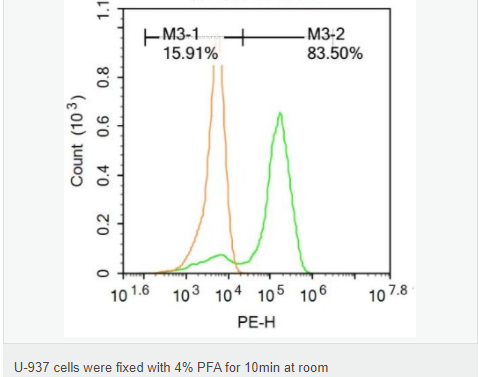

货号
产品规格
售价
备注
BN40228R-100ul
100ul
¥2360.00
交叉反应:Human(predicted:Mouse,Rat,Chicken,Dog,Pig,Cow,Horse) 推荐应用:Flow-Cyt,ELISA
BN40228R-200ul
200ul
¥3490.00
交叉反应:Human(predicted:Mouse,Rat,Chicken,Dog,Pig,Cow,Horse) 推荐应用:Flow-Cyt,ELISA
产品描述
| 英文名称 | NFkB p100 / p52 |
| 中文名称 | 细胞核因子/k基因结合核因子 p52/p100抗体 |
| 别 名 | NFκB-p100/p52; NFkB p100; p52; DNA binding factor KBF2; H2TF1; Lymphocyte translocation chromosome 10; Lyt10; Oncogene Lyt 10; DNA binding factor KBF2; DNA-binding factor KBF2; H2TF1; Lymphocyte translocation chromosome 10; Lymphocyte translocation chromosome 10 protein; Lyt 10; Lyt10; NFKB2; NFKB2_HUMAN; Nuclear factor NF kappa B p100 subunit; Nuclear factor NF kappa B p52 subunit; Nuclear factor NF-kappa-B p52 subunit; Nuclear factor of kappa light polypeptide gene enhancer in B cells 2; Nuclear factor of kappa light polypeptide gene enhancer in B-cells 2; Oncogene Lyt 10; Oncogene Lyt-10; p49/p100. |
| 研究领域 | 肿瘤 细胞生物 信号转导 细胞凋亡 转录调节因子 激酶和磷酸酶 表观遗传学 |
| 抗体来源 | Rabbit |
| 克隆类型 | Polyclonal |
| 交叉反应 | Human, (predicted: Mouse, Rat, Chicken, Dog, Pig, Cow, Horse, ) |
| 产品应用 | ELISA=1:5000-10000 Flow-Cyt=1ug/test not yet tested in other applications. optimal dilutions/concentrations should be determined by the end user. |
| 分 子 量 | 50, 100kDa |
| 细胞定位 | 细胞核 细胞浆 |
| 性 状 | Liquid |
| 浓 度 | 1mg/ml |
| 免 疫 原 | KLH conjugated synthetic peptide derived from human NFKB p52:151-250/900 |
| 亚 型 | IgG |
| 纯化方法 | affinity purified by Protein A |
| 储 存 液 | 0.01M TBS(pH7.4) with 1% BSA, 0.03% Proclin300 and 50% Glycerol. |
| 保存条件 | Shipped at 4℃. Store at -20 °C for one year. Avoid repeated freeze/thaw cycles. |
| PubMed | PubMed |
| 产品介绍 | NFkB is formed through the association of multiple subunits, either as a homodimer or heterodimer. Subunits have been identified as p50 (NFkB1), p65 (RelA), c-Rel, RelB and p52 (NFkB2). The classic NFkB form exists as a p50-p65 heterodimer and predominates in many cell types. Many of the possible combinatorial forms of homo- and heterodimers have been identified and growing evidence indicates that different forms of NFkB have different functions in cells. Interestingly, both the p50 and p52 subunits are derived from the precursor proteins p105 and p100 respectively, that each contain multiple copies of the so called ankyrin repeat at their C termini. Nuclear translocation of NFkB is confirmed by the use of electrophorectic mobility shift assays or by immunoblotting with nuclear extracts. The subunit composition of NFkB is confirmed by the use of antibodies that "supershift" the DNA/protein complex. Function: NF-kappa-B is a pleiotropic transcription factor present in almost all cell types and is the endpoint of a series of signal transduction events that are initiated by a vast array of stimuli related to many biological processes such as inflammation, immunity, differentiation, cell growth, tumorigenesis and apoptosis. NF-kappa-B is a homo- or heterodimeric complex formed by the Rel-like domain-containing proteins RELA/p65, RELB, NFKB1/p105, NFKB1/p50, REL and NFKB2/p52. The dimers bind at kappa-B sites in the DNA of their target genes and the individual dimers have distinct preferences for different kappa-B sites that they can bind with distinguishable affinity and specificity. Different dimer combinations act as transcriptional activators or repressors, respectively. NF-kappa-B is controlled by various mechanisms of post-translational modification and subcellular compartmentalization as well as by interactions with other cofactors or corepressors. NF-kappa-B complexes are held in the cytoplasm in an inactive state complexed with members of the NF-kappa-B inhibitor (I-kappa-B) family. In a conventional activation pathway, I-kappa-B is phosphorylated by I-kappa-B kinases (IKKs) in response to different activators, subsequently degraded thus liberating the active NF-kappa-B complex which translocates to the nucleus. In a non-canonical activation pathway, the MAP3K14-activated CHUK/IKKA homodimer phosphorylates NFKB2/p100 associated with RelB, inducing its proteolytic processing to NFKB2/p52 and the formation of NF-kappa-B RelB-p52 complexes. The NF-kappa-B heterodimeric RelB-p52 complex is a transcriptional activator. The NF-kappa-B p52-p52 homodimer is a transcriptional repressor. NFKB2 appears to have dual functions such as cytoplasmic retention of attached NF-kappa-B proteins by p100 and generation of p52 by a cotranslational processing. The proteasome-mediated process ensures the production of both p52 and p100 and preserves their independent function. p52 binds to the kappa-B consensus sequence 5'-GGRNNYYCC-3', located in the enhancer region of genes involved in immune response and acute phase reactions. p52 and p100 are respectively the minor and major form; the processing of p100 being relatively poor. Isoform p49 is a subunit of the NF-kappa-B protein complex, which stimulates the HIV enhancer in synergy with p65. Subunit: Component of the NF-kappa-B RelB-p52 complex. Homodimer; component of the NF-kappa-B p52-p52 complex. Component of the NF-kappa-B p65-p52 complex. Component of the NF-kappa-B p52-c-Rel complex. NFKB2/p52 interacts with NFKBIE. Component of a complex consisting of the NF-kappa-B p50-p50 homodimer and BCL3. Directly interacts with MEN1. Subcellular Location: Nucleus. Cytoplasm. Note=Nuclear, but also found in the cytoplasm in an inactive form complexed to an inhibitor (I-kappa-B). Post-translational modifications: While translation occurs, the particular unfolded structure after the GRR repeat promotes the generation of p52 making it an acceptable substrate for the proteasome. This process is known as cotranslational processing. The processed form is active and the unprocessed form acts as an inhibitor (I kappa B-like), being able to form cytosolic complexes with NF-kappa B, trapping it in the cytoplasm. Complete folding of the region downstream of the GRR repeat precludes processing. Subsequent to MAP3K14-dependent serine phosphorylation, p100 polyubiquitination occurs then triggering its proteasome-dependent processing. Constitutive processing is tightly suppressed by its C-terminal processing inhibitory domain, named PID, which contains the death domain. DISEASE: Note=A chromosomal aberration involving NFKB2 is found in a case of B-cell non Hodgkin lymphoma (B-NHL). Translocation t(10;14)(q24;q32) with IGHA1. The resulting oncogene is also called Lyt-10C alpha variant. Note=A chromosomal aberration involving NFKB2 is found in a cutaneous T-cell leukemia (C-TCL) cell line. This rearrangement produces the p80HT gene which encodes for a truncated 80 kDa protein (p80HT). Note=In B-cell leukemia (B-CLL) cell line, LB40 and EB308, can be found after heterogeneous chromosomal aberrations, such as internal deletions. Similarity: Contains 7 ANK repeats. Contains 1 death domain. Contains 1 RHD (Rel-like) domain. SWISS: Q00653 Gene ID: 4791 Database links: Entrez Gene: 4791 Human Entrez Gene: 18034 Mouse Omim: 164012 Human SwissProt: Q00653 Human SwissProt: Q9WTK5 Mouse Unigene: 73090 Human Unigene: 102365 Mouse Unigene: 204814 Rat Important Note: This product as supplied is intended for research use only, not for use in human, therapeutic or diagnostic applications. |
